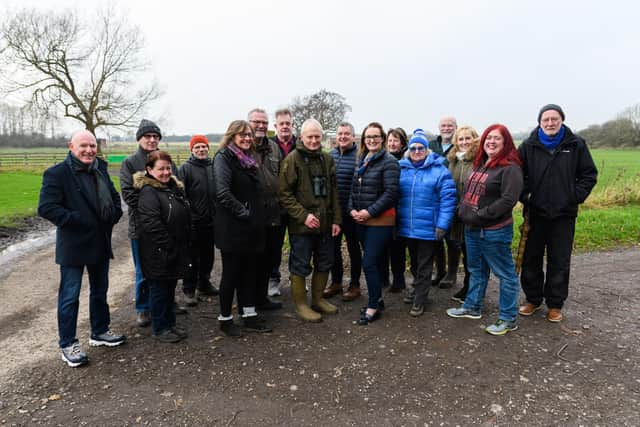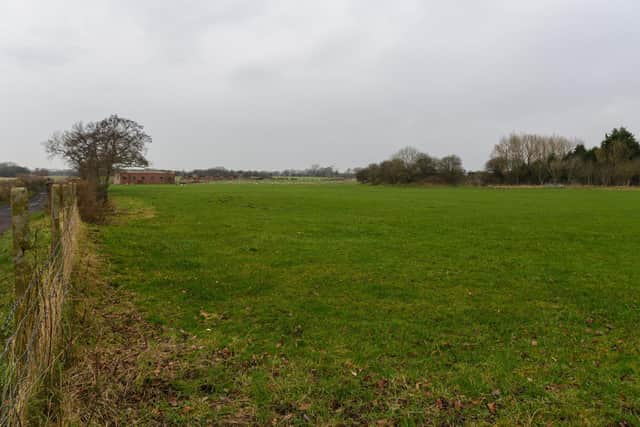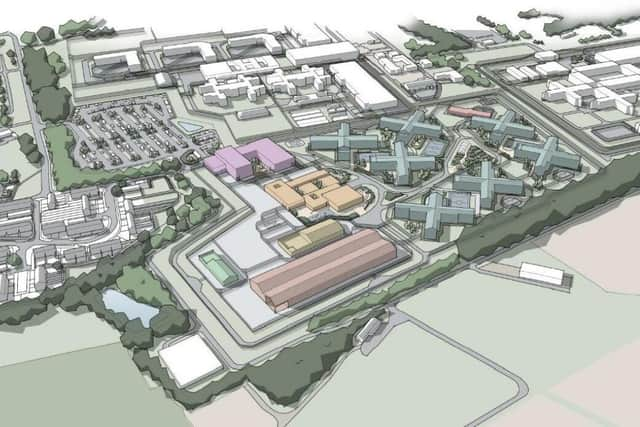Plan for 'super prison' on Chorley and Leyland border is rejected
and live on Freeview channel 276
Residents of a Chorley village have been given reason to rejoice just days before Christmas after controversial plans for a so-called “super prison” were rejected by councillors.
Locals in and around Ulnes Walton had mounted a campaign against a government proposal to build a third jail in their area, on land close to the existing Garth and Wymott lock-ups.


Advertisement
Hide AdAdvertisement
Hide AdChorley Council planning officers had recommended that permission be granted for the 1,715-inmate facility, which would have seen the combined prison population in the locality outstrip the number of residents living in the village.
However, members of the authority’s planning committee dismissed the application by the Ministry of Justice (MoJ) - citing concerns over damage to the greenbelt, road safety and the impact of increased traffic on those living nearby.
Villagers had battled against the blueprint since it was put forward earlier this year and, as the Post revealed in October, their resolve was only strengthened after it emerged that the proposal would have involved relocating a bus stop - used by schoolchildren - to within the prison grounds.
Speaking after the meeting where the plans were rejected, Emma Curtis, from the Action Against Wymott and Garth Third Prison group, said that residents were “absolutely elated” by the decision.


Advertisement
Hide AdAdvertisement
Hide AdShe added that the result was a victory for “a small community that pulled together and stood up for what’s right and what they believe in” - and she praised committee members for upholding “the values of their [own] planning policies”.
The planned category C jail would have acted as a resettlement prison for male offenders, preparing them for their eventual release. Some of the inmates may have been allowed out on temporary licence to go to work.
The development was intended to help fulfil a government commitment to deliver a total of 18,000 new prison places by the mid-2020s.
A litany of claimed benefits advanced by the MoJ was presented to the committee, both in person and on paper - including the creation of 643 full-time equivalent jobs once the jail was in operation, over £10m in locally-retained expenditure by prison staff and visitors and the creation of a new bowling green facility to replace one that would be lost as a result of the development,


Advertisement
Hide AdAdvertisement
Hide AdIt was also suggested that the new prison places on the Chorley/South Ribble border would “meet an identified need, in the right geographical location”.
As the proposed 43 hectare site is a greenbelt plot - currently split between agricultural use and an area reserved for the existing prisons - the government also had to demonstrate that “very special circumstances” existed to justify its development.
Councillors were told that an extensive site selection process had taken place, with more than a dozen possible locations identified - but that Ulnes Walton was the only one left standing after assessment against criteria including accessibility, environmental and operational suitability and the need for one of four proposed new facilities across the country to be located in the North West.
Data from November 2020 shows that there were more than 1,100 male prison inmates with less than two years to serve of their sentences and who had North West addresses - but were being held in prisons outside of the region.
Advertisement
Hide AdAdvertisement
Hide AdHowever, most members of the committee - and some other borough and parish councillors - were unconvinced by the case brought in favour of the prison plan.
Committee member Aaron Beaver said he could not believe that there was not “a better site” somewhere else, while Croston, Mawdesley and Euxton South ward councillor Alan Platt told the meeting that two prisons were “more than enough” for the local area.
Cllr Alan Whittaker told his colleagues in the committee that the MoJ was attempting to “justify the unjustifiable” by the way in which it had presented the proposed prison development as a viable option.
He said: “They have come to the conclusion that this would be the best value [site] in the region. It might be the best value for the Ministry of Justice but it's not the best value for this community in Chorley.”
Advertisement
Hide AdAdvertisement
Hide AdHighway safety and capacity were also highlighted as a particular concern - as was a claimed dearth of sustainable transport options that could be used to reach the site.
As the highways authority, Lancashire County Council had requested a range of road improvements be demanded as part of any planning consent - including £500,000 of upgrade work along the A581 corridor and traffic-calming measures in the vicinity of the new prison.
In spite of agreement with the MoJ on the measures requested, committee member Martin Boardman said that the only way that traffic issues could truly be resolved was by considering an alternative access route entirely, describing the current proposal as “seriously flawed” and suggesting that the “bigger picture” needed to be explored.
“Any traffic, whether construction or visiting traffic…coming from the west will have to travel through Croston, coming from the east will have to come through Charnock Richard, Euxton and Ulnes Walton, coming from the south will come through Eccleston, Mawdesley and Heskin and coming from the north, it will come through Preston,” Cllr Boardman said.
Advertisement
Hide AdAdvertisement
Hide AdCllr Whittaker added that prison staff were all likely to access the site by car - rather than bus or bike, particularly in the winter months - and questioned what would happen when five years’ worth of funding for a new bus service for the facility, promised as part of the planning application, had expired.
Ulnes Walton parish councillor Paul Dodenhoff also noted that the A581 had been identified by national motoring organisations as “one of the UK’s most dangerous roads”.
More than 130 objections were lodged to the proposal. Emma Curtis told the committee that residents of Ulnes Walton had “chosen to live in a rural, peaceful area and paid a premium to do so”.
She added: “Currently, no traffic associated [with] the two existing prisons comes along Moss Lane. It has less than 200 vehicles that use it on a daily basis - less at the weekend.
Advertisement
Hide AdAdvertisement
Hide Ad“By allowing the car park and entrance in the proposed location, it will bring a significant increase in traffic, noise and pollution, reducing the air quality, not just during the construction phase. but also once the site is open - with the addition of up to 2,000 vehicle movements daily.
“The safeguarding of children also needs great consideration. They use Moss Lane to ride their bikes, play near the trees and on the grass verges. The large volume of traffic and size of vehicles from 7am until 9pm, seven days a week, will mean this is no longer possible,” Ms. Curtis said.
On the basis that the proposal did not pass the “very special circumstances test for greenbelt development - and concerns over its impact on highway safety and residential amenity - committee members voted by 12 votes to one to reject the application.
Had they approved the plans, the matter would still have had to be referred to the National Planning Casework Unit to determine whether the Communities Secretary wanted to “call in” the application for his own consideration.
Advertisement
Hide AdAdvertisement
Hide AdThe Post understands that, in spite of the complex nature of the process that would have been set in train by a different committee decision, an appeal against that decision is now the only way in which the prison plan could ever be brought back tot he table.
Responding to the outcome of the meeting, a spokesperson for the Ministry of Justice said: “We are considering the council’s decision and will continue to work closely with local authorities and the community.”
Emma Curtis says that she and fellow campaigners are braced for the possibility that they may yet have to renew their efforts in the months to come - and said they will “deal with whatever comes in the new year”.
“For now, though, we’re just enjoying the win,” she added.
IN NUMBERS
1,715 - capacity of proposed new Ulnes Walton prison
1,200 - number of inmates at Wymott Prison
850 - number of inmates at Garth Prison
2,671 - residents of Ulnes Walton
Sources: Ministry of Justice, Chorley Council and 2011 census
